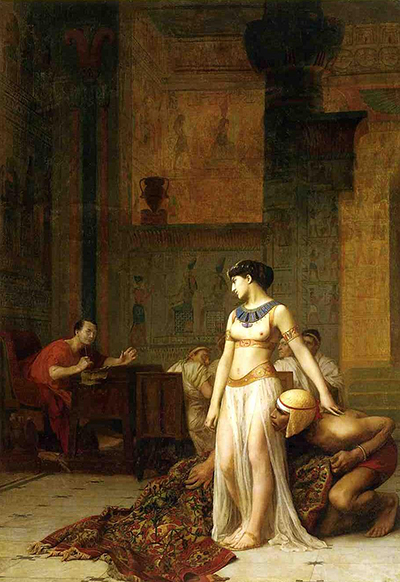The Cleopatra and Caesar by Jean-Leon Gerome is an oil on canvas piece finished in 1866. Gerome was a French sculpture and painter, whose style is now recognised as Academicism. He painted a range of pieces including historical, Orientalism, Greek mythology, portraits and other subjects, which brought an artistic climax to academic traditional painting.
The Cleopatra and Caesar is an oil on canvas standing at 183cm x 129.5 cm. French courtesan, La Paiva, commissioned the painting, but returned it to Gerome as she was unhappy with the completed painting. In 1866 it was displayed at the Salon and at the Royal Academy of Arts in 1871.
The work is one of the first modern illustrations of Cleopatra. Cleopatra is shown emerging from a carpet, which is considered a historical inaccuracy because of a translation error from Plutarch’s Life of Caesar. The painting is acknowledged as a fine example of Egyptomania and reached a global audience due to mass-production by Goupil.
The scene in the painting is based on a text from the Life of Caesar by Greek historian Plutarch. To help create a realistic portrayal of the scene, Gerome visited Egypt in 1857 to collected many local colours and observe precise details. The background itself is based on a temple at Deir el-Medina described in the Description de l’Egypte.
Depicting the year 47 BC, the painting shows Cleopatra being revealed by her servant, Apollodorus. He is shown bent down assisting her out from a rug used to smuggle her into the palace. Julius Caesar is in the picture's background looking at Cleopatra, as he is sat at the head of a table with some aids further down.
The figures in the painting are roughly half the size. Containing decadence, nudity, slavery and sex, the painting is described as a typical example of Egyptomania. The painting is considered a companion to an early piece of Gerome’s work called ‘Phryne before the Areopagus’ (1861), which, along with ‘Cleopatra and the Peasant’ (1838) by Eugene Delacroix, is one of only two distinguished portrayals of Cleopatra from the nineteenth century.
In its early creation, this piece has also been known as ‘Cleopatra Before Caesar’. In 1870, the painting was purchased by Darius Ogden Mills, a New York real estate developer, philanthropist and Californian banker. It stayed in the art collection of the Mills until a private collector bought the piece in 1990, where it remains.




